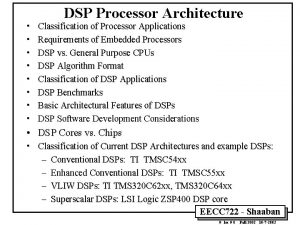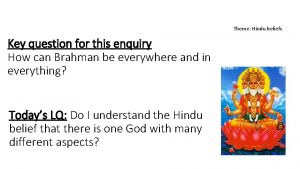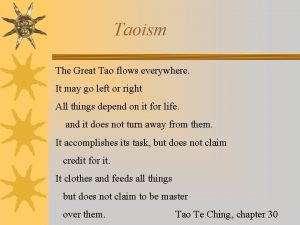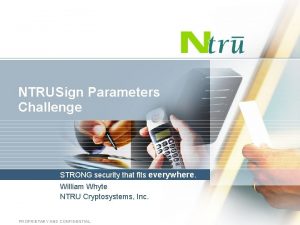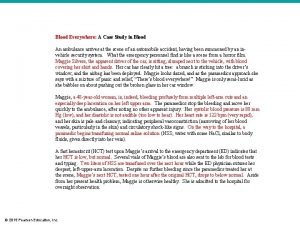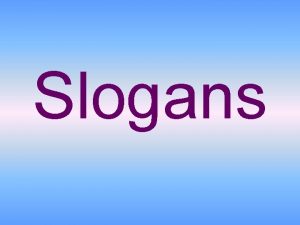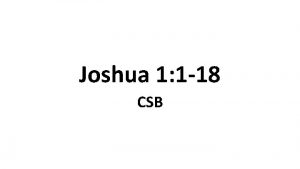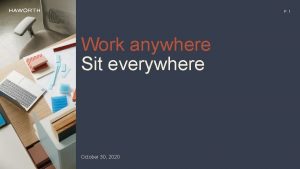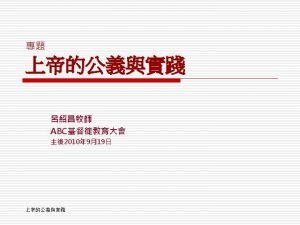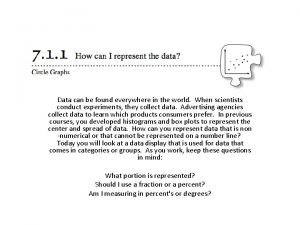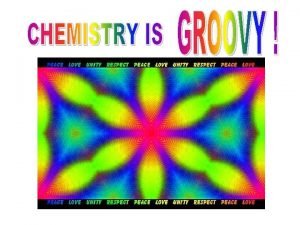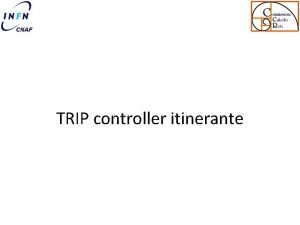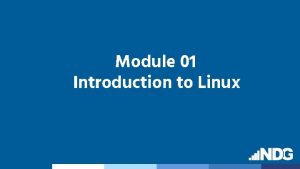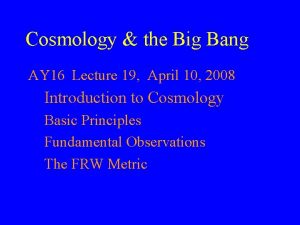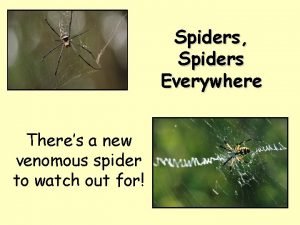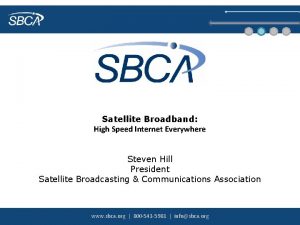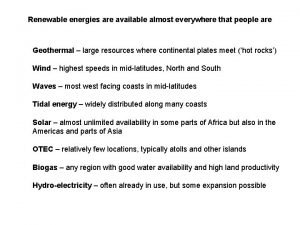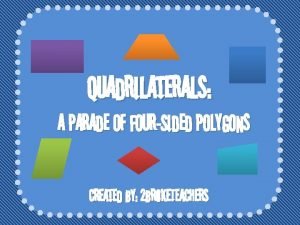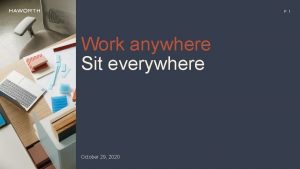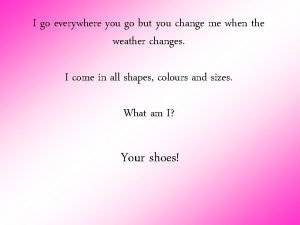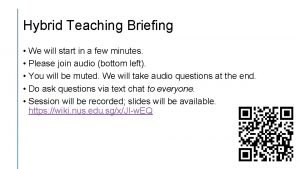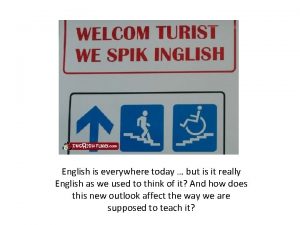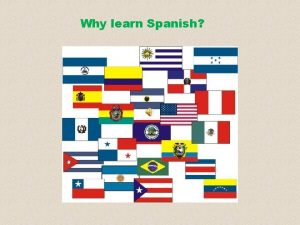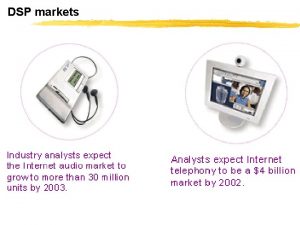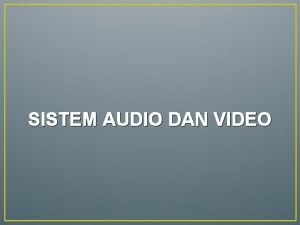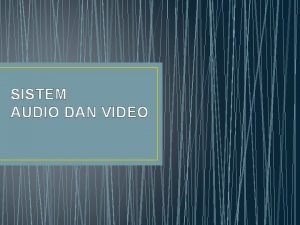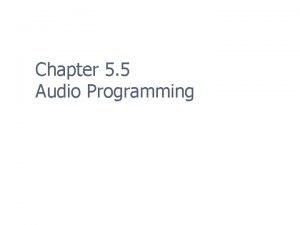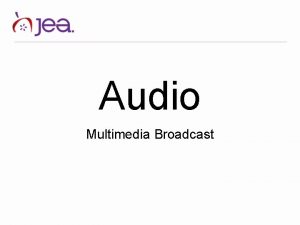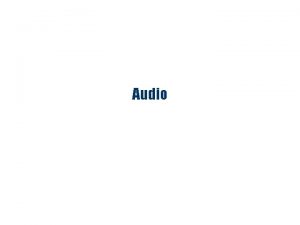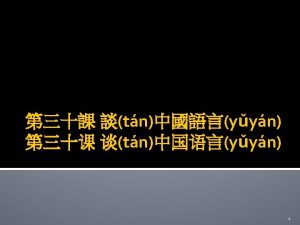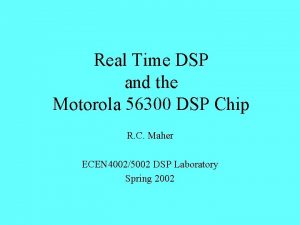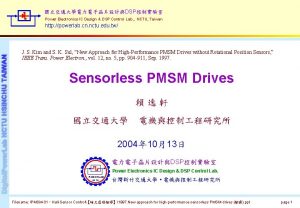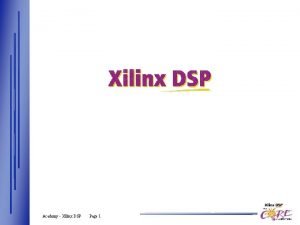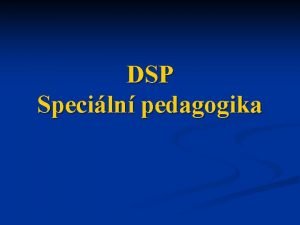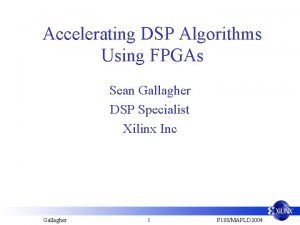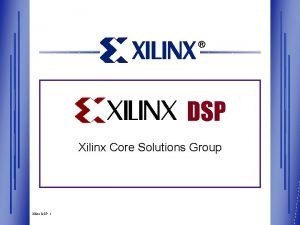DSP Everywhere Applications of DSP in Audio and



























![AEC based on Adaptive Filtering • Goal: Identify acoustic impulse response h[k] and subtract AEC based on Adaptive Filtering • Goal: Identify acoustic impulse response h[k] and subtract](https://slidetodoc.com/presentation_image_h/3305b6f4c9cffe29c9f8b6186571ac05/image-28.jpg)




















- Slides: 48

DSP Everywhere… Applications of DSP in Audio and Digital Communications Simon Doclo Dept. Elec. Engineering, K. U. Leuven simon. doclo@esat. kuleuven. ac. be www. esat. kuleuven. ac. be/~doclo/ DSP-II p. 1

Introduction • DSP in Digital Communications • Wireless systems: GSM, WLAN • 3 G-systems: UMTS, CDMA • Modems: Cable, ADSL, VDSL • Line echo cancellation • Satellite communications • Optical communication 14/12/01 Simon Doclo DSP Everywhere… p. 2

Introduction • DSP in Audio Applications • Audio and speech coding • Audio effects • Tele-conferencing • Voice-controlled systems • Hands-free telephony • Hearing aids / cochlear implants 14/12/01 Simon Doclo DSP Everywhere… p. 3

Introduction • Other applications • Image and video processing • Medical applications • Cryptography Anywhere (digital) signals are present, DSP-techniques are required! • Process control in chemical, pharmaceutical, energy plants • … 14/12/01 Simon Doclo DSP Everywhere… p. 4

Overview • Introduction • DSP in digital communications systems: – x. DSL-modems: modulation, equalisation • DSP in audio applications: – Hands-free communication: echo, noise and reverberation – Basic techniques: • Acoustic echo cancellation (AEC) • Multi-microphone beamforming – Application: hearing aids • Conclusion 14/12/01 Simon Doclo DSP Everywhere… p. 5

Telephone Line modems • High-speed data communication: – optical, cable, wireless, telephone line • Telephone Line Modems – voice-band modems : up to 56 kbits/sec in 0… 4 k. Hz band – ADSL modems : up to 6 Mbits/sec in 30 k. Hz… 1 MHz band – VDSL modems : up to 52 Mbits/sec in … 10 MHz band • Time to download 10 Mbyte-file: 14/12/01 Modem Time 56 Kbps voice-band modem 24 minutes 128 Kbps ISDN 10 minutes 6 Mbps ADSL 13 seconds 52 Mbps VDSL 1. 5 seconds Simon Doclo DSP Everywhere… p. 6

x. DSL Modems • ADSL : ‘Asymmetric Digital Subscriber Line’ • HDSL : ‘High Speed Digital Subscriber Line’ • VDSL : ‘Very High Speed Digital Subscriber Line’ …-1993: ADSL spurred by interest in video-on-demand (VOD) 1995 : ADSL/VOD interest decline 1996 : ADSL technology trials prove viability. 1997 -. . . : ADSL deployment, reoriented to data applications, as telco’s reaction to cable operators offering highspeed internet access with cable modems 2000 -… : VDSL 14/12/01 Simon Doclo DSP Everywhere… p. 7

x. DSL Modems Downstream Copper wire Central office Upstream Subscriber • Analog/digital telephone network: BW 3 k. Hz, SNR 35 d. B Shannon capacity • ADSL/VDSL: higher bandwidth, lower SNR + impairments • Bitrate depends on length of copper line Down Up Length Bandwidth ADSL 6 Mbps 640 Kbps 3 km 1. 1 MHz VDSL 52 Mbps 6. 4 Mbps 300 m 12 MHz vb. 14/12/01 Simon Doclo DSP Everywhere… p. 8

DMT Principles: IFFT/FFT-based modulation • Modulation-technique : DMT (Discrete Multitone) • Basic idea: – Decompose frequency into ‘tones’ (FFT/IFFT) – Assign bits according to SNR per tone SNR bits/toon frequentie – ADSL spec (=ANSI standard): • 256 tones, 512 -point (I)FFTs • carrier spacing fo= 4. 3215 k. Hz, basic sampling rate 2. 21 MHz (=512*4. 3215 k. Hz) – VDSL (=proposal): up to 4096 tones, same carrier spacing 14/12/01 Simon Doclo DSP Everywhere… p. 9

ADSL Spectrum • ADSL spectrum : 14/12/01 Simon Doclo DSP Everywhere… p. 10

Communication impairments (1) • Frequency-dependent channel attenuation introduces intersymbol interference (ISI) equalization • Coupling between wires in same or adjacent binders introduces crosstalk (XT) useful signal – Near-end Xtalk (NEXT) – Far-end Xtalk (FEXT) – Other systems (e. g. HPNA) NEXT FEXT • Radio Frequency Interference (RFI): e. g. AM broadcast, amateur radio • Noise: e. g. impulsive noise (=high bursts of short duration) • Echo: due to hybrid impedance mismatch echo cancellation Conclusion: Need advanced modulation, DSP, etc. ! 14/12/01 Simon Doclo DSP Everywhere… p. 11

Communication impairments (2) • ADSL channel attenuation, crosstalk, noise 14/12/01 Simon Doclo DSP Everywhere… p. 12

Modulation - Demodulation (1) • DMT-transmission block scheme: 4 -QAM IFFT 8 -QAM P / S Discrete equivalent channel S / P FFT FEQ Bitstream (freq domain) 14/12/01 Modulation (IFFT) Simon Doclo Time domain Demodulation Equalisation signal (FFT) DSP Everywhere… p. 13

Modulation - Demodulation (2) • Transmission: modulation is realized by means of 2 Npoint Inverse Discrete Fourier Transform (IFFT) (example N=4 ) real • Receiver: demodulation with inverse operation, i. e. FFT 14/12/01 Simon Doclo DSP Everywhere… p. 14

The Magic Prefix Trick (1) Additional feature : before transmission, a ‘prefix’ is added to each time-domain symbol, i. e. the last samples are copied and put up front : 14/12/01 Simon Doclo DSP Everywhere… p. 15

The Magic Prefix Trick (2) Prefix insertion : • in the receiver, the samples corresponding to the prefix are removed (=unused) : IFFT P / S Discrete equivalent channel S / P FFT FEQ 14/12/01 Simon Doclo DSP Everywhere… p. 16

The Magic Prefix Trick (3) • if channel impulse response has length L (= L non-zero taps) and ( is prefix length), then all ‘transient effects’ between symbols are confined to the prefix period : Tx-side Rx-side Channel ch(t) Tone 3 Tone 2 Tone 1 s(t) Tone 0 Prefix 14/12/01 From IFFT Simon Doclo * Tone 3 Tone 2 r(t) Tone 1 Tone 0 Guardband To FFT DSP Everywhere… p. 17

The Magic Prefix Trick (4) • Magic trick fails if , resulting in – inter-symbol-interference (ISI) = interference from previous symbol(s) (same carrier) – inter-carrier interference (ICI) = interference from other carriers • In the receiver, after removing the samples corresponding to the prefix, the i-th tone is observed, multiplied by a factor H(i. fo), i. e. the channel response for frequency f=i. fo • ‘Prefix trick’ is based on a linear convolution (filtering by channel impulse response) being turned into a circular convolution, which corresponds to component-wise multiplication in frequency domain easy equalization ! 14/12/01 Simon Doclo DSP Everywhere… p. 18

Overview • Introduction • DSP in digital communications systems: – x. DSL-modems: modulation, equalisation • DSP in audio applications: – Hands-free communication: echo, noise and reverberation – Basic techniques: • Acoustic echo cancellation (AEC) • Multi-microphone beamforming – Application: hearing aids • Conclusion 14/12/01 Simon Doclo DSP Everywhere… p. 19

Hands-free communication • Recorded microphone signals are corrupted by: • Far-end echoes acoustic echo cancellation • Acoustic background noise suppression • Room reverberation dereverberation • Application: hands-free telephony, hearing aids, voice control 14/12/01 Simon Doclo DSP Everywhere… p. 20

Signal model: some maths… • Multi-microphone signal enhancement algorithms: – Extract clean speech/audio signal from microphone recordings – Exploit spatial and frequency diversity between speech and noise • Microphone signals (m=1…M): unknown (=loudspeaker signal) • Output signal: compute filters g[k] : – echo cancellation: – noise reduction/dereverberation: • gm[k] cancels noise components • gm[k] focuses on speech s[k] 14/12/01 Simon Doclo DSP Everywhere… p. 21

Overview • Introduction • DSP in digital communications systems: – x. DSL-modems: modulation, equalisation • DSP in audio applications: – Hands-free communication: echo, noise and reverberation – Basic techniques: • Acoustic echo cancellation (AEC) • Multi-microphone beamforming – Application: hearing aids • Conclusion 14/12/01 Simon Doclo DSP Everywhere… p. 22

Acoustic echo cancellation (AEC) Suppress acoustic and line echo: – to guarantee normal conversation conditions : users do not like to hear a delayed and filtered version of their own voice – to prevent the closed-loop system from becoming unstable if amplification is too high 14/12/01 Simon Doclo DSP Everywhere… p. 23

Room Acoustics • Propagation of sound waves in an acoustic environment results in – signal attenuation – spectral distortion • The attenuation and distortion can be modeled quite well as a linear filtering operation • Non-linear distortion mainly stems from the loudspeakers. Its effect is typically of second order, therefore (often) not taken into account • The linear filter h[k] modeling the acoustic path between loudspeaker and microphone is represented by the acoustic impulse response 14/12/01 Simon Doclo DSP Everywhere… p. 24

Acoustic Impulse Response (1) Different parts: – dead time – direct path impulse and early reflections, which depend on the geometry of the room – an exponentially decaying tail called reverberation, coming from multiple reflections – For typical applications the impulse reponse is between 100 and 400 ms long several 100 to 1000 taps @ 8 -16 k. Hz memory requirement for circular buffers in DSP – Because people move around in the recording room, the acoustic impulse response is highly time-varying 14/12/01 Simon Doclo DSP Everywhere… p. 25

Acoustic Impulse Response (2) ESAT speech laboratory : Paleis voor Schone Kunsten : T 60 120 ms T 60 1500 ms Original speech signal : 14/12/01 Simon Doclo DSP Everywhere… p. 26

Acoustic Impulse Response : FIR or IIR ? • If the acoustic impulse response is modeled as – an FIR filter many hundreds to several thousands of filter taps are required – an IIR filter order can be reduced, but still several hundreds of filter coefficients are required (=‘bad’ model for acoustic impulse response) – Remark: IIR-filters good model for classical filters (LP, HP, BS) • hence FIR models are typically used in practice – as they are guaranteed to be stable – as adaptive filtering techniques are called for: • FIR adaptive filters are easier than IIR adaptive filters 14/12/01 Simon Doclo DSP Everywhere… p. 27
![AEC based on Adaptive Filtering Goal Identify acoustic impulse response hk and subtract AEC based on Adaptive Filtering • Goal: Identify acoustic impulse response h[k] and subtract](https://slidetodoc.com/presentation_image_h/3305b6f4c9cffe29c9f8b6186571ac05/image-28.jpg)
AEC based on Adaptive Filtering • Goal: Identify acoustic impulse response h[k] and subtract filtered loudspeaker signal from microphone signal • Thanks to the adaptivity – time-varying acoustics can be tracked – AEC is ‘self-learning’ – performance superior to performance of conventional techniques 14/12/01 Simon Doclo DSP Everywhere… p. 28

Adaptive Filtering Algorithms • Algorithm: 2 steps – Filter loudspeaker signal error signal indicates how close this signal is to recorded microphone signal – Update filter: update depends on error signal filtered signal desired signal 14/12/01 Simon Doclo DSP Everywhere… error signal p. 29

Normalized Least Mean Square (NLMS) Data filtering with Filter update Circular data buffer Filter coefficients L is the adaptive filter length, is the adaptation stepsize, is a regularization parameter and k is the discrete-time index 14/12/01 Simon Doclo DSP Everywhere… p. 30

Control Algorithm • ‘AEC is more than just an adaptive filter’ : – adaptive filter is supplemented with control software, which mainly controls the adaptation speed (e. g. no adaptation during double-talk) – In practice echo suppression is limited to 30 d. B due to time-variance, non-linearities, finite filterlength postprocessing (e. g. center-clipping) 14/12/01 Simon Doclo DSP Everywhere… p. 31

Real-time DSP Implementation (1) • AEC-implementation on DSP (lab equipment): – TMS 320 C 44 @ 50 MHz : data acquisition (ADC/DAC) – TMS 320 C 40 @ 50 MHz : acoustic echo cancellation (AEC) AEC 14/12/01 Simon Doclo ADC/DAC DSP Everywhere… p. 32

Real-time DSP Implementation (2) • Adaptive filtering part : several algorithms can be selected – NLMS : time-domain algorithm – PB-FDAF : frequency-domain algorithm (better performance) • Control software – double-talk detection – non-linear postprocessing algorithm • Variable sampling rate – Common sampling rates for speech applications: 8 k. Hz, 16 k. Hz – for audio applications: 22. 05 k. Hz, 44. 1 k. Hz, 48 k. Hz • Echo paths up to 325 ms can be modeled and tracked with the FDAF based on LMS at 8 k. Hz sampling frequency and 16 ms delay 14/12/01 Simon Doclo DSP Everywhere… p. 33

Real-time DSP Implementation (3) Execution times for the most important blocks of the DSP code were measured : N=768 FFT-size=128 fs=8000 Hz block 64 samples = 8 ms 14/12/01 Simon Doclo DSP Everywhere… p. 34

Demo Local speaker Output AEC without Double-talk Detection Far-end signal Near-end signal 14/12/01 Simon Doclo DSP Everywhere… p. 35

Overview • Introduction • DSP in digital communications systems: – x. DSL-modems: modulation, equalisation • DSP in audio applications: – Hands-free communication: echo, noise and reverberation – Basic techniques: • Acoustic echo cancellation (AEC) • Multi-microphone beamforming – Application: hearing aids • Conclusion 14/12/01 Simon Doclo DSP Everywhere… p. 36

Beamforming basics • Background/history: antenna array design for RADAR • Array elements are combined electronically such that: – array can be steered towards specific direction higher directivity – beam shaping is possible • Beamforming for hands-free communication : – focus beam on speech source(s) speech enhancement and dereverberation – put spatial nulls in direction of noise sources noise reduction • Classification: – fixed beamforming: data-independent fixed filters gm[k] e. g. delay-and-sum, weighted-sum, filter-and-sum – adaptive beamforming: data-dependent adaptive filters gm[k] e. g. LCMV-beamformer, Generalized Sidelobe Canceller 14/12/01 Simon Doclo DSP Everywhere… p. 37

Delay-and-sum beamforming (1) • Microphone signals are delayed and summed together array can be virtually steered to angle • Angular selectivity is obtained, based on constructive ( = ) and destructive ( ) interference • Uniform delay-and-sum beamforming implies – Uniform array equal inter-microphone distance – Uniformly distributed delays 14/12/01 Simon Doclo DSP Everywhere… p. 38

Delay-and-sum beamforming (2) • Spatial directivity pattern H( , ) for uniform DS-beamformer M=5 microphones d=3 cm inter-microphone distance =60 steering angle fs=16 k. Hz sampling frequency • H( , ) has sinc-like shape and is frequency-dependent 14/12/01 Simon Doclo DSP Everywhere… p. 39

Delay-and-sum beamforming (3) • For an ambiguity, called spatial aliasing, occurs. This is analogous to time-domain aliasing where now the spatial sampling (=d) is too large. M=5, =60 , fs=16 k. Hz, d=8 cm Spatial aliasing 14/12/01 Simon Doclo DSP Everywhere… p. 40

Filter-and-sum beamformer • Better directivity patterns than DS-beamformer are obtained with weighted-sum and filter-and-sum beamformers – e. g. Frequency-independent directivity pattern M=8 Logarithmic array L=50 =90 fs=8 k. Hz 14/12/01 Simon Doclo DSP Everywhere… p. 41

Adaptive beamforming • Adaptive filter-and-sum structure: – Minimize noise output power, while maintaining a chosen frequency response in look direction (and/or other linear constraints) – LCMV = Linearly Constrained Minimum Variance • minimize variance of output z[k] • in order to avoid desired signal to be distorted or cancelled out, J linear constraints are added 14/12/01 Simon Doclo DSP Everywhere… p. 42

Generalized Sidelobe Canceller (1) • GSC consists of three parts: – Fixed (delay-and-sum) beamformer, in order to achieve spatial alignment of speech source speech reference – Blocking matrix, placing spatial nulls in the direction of the speech source noise references – Multi-channel adaptive filter with delay Postproc 14/12/01 Simon Doclo DSP Everywhere… p. 43

Generalized Sidelobe Canceller (2) • Blocking matrix Ca : – creating maximum M-1 independent noise references by placing spatial nulls in look-direction – different possibilities: e. g. Griffiths-Jim, Walsh broadside • Problems of GSC: – impossible to reduce noise from look-direction – reverberation effects cause signal leakage in noise reference adaptive filter is only updated when no speech is present ! 14/12/01 Simon Doclo DSP Everywhere… p. 44

Overview • Introduction • DSP in digital communications systems: – x. DSL-modems: modulation, equalisation • DSP in audio applications: – Hands-free communication: echo, noise and reverberation – Basic techniques: • Acoustic echo cancellation (AEC) • Multi-microphone beamforming – Application: hearing aids • Conclusion 14/12/01 Simon Doclo DSP Everywhere… p. 45

Application: Hearing Aids (1) • Hearing problems are very common nowadays • Most of the users are dissatisfied with the performance of their hearing aid in noisy environments (cocktail party effect) increase speech intelligibility by reducing background noise • Traditional hearing aids: – one microphone, analog, limited signal processing – amplification of all incoming sound without distinction between different sound sources • Enabling technologies: – microphone miniaturisation integrate multiple microphones into one hearing aid – micro-electronics: size ASIC < 10 mm 2, low power consumption – advanced DSP techniques (noise reduction, feedback suppression) 14/12/01 Simon Doclo DSP Everywhere… p. 46

Application: Hearing Aids (2) • Improvement of speech intelligibility by reduction of background noise • BTE hearing aid with 2 (or more) closely-spaced microphones • GSC in switched mode: • Beamfomer : weights can be adapted during speech • Noise suppression (ANC) : only adaptation during noise • Speech detection : determine when speech is present 14/12/01 Simon Doclo DSP Everywhere… p. 47

Conclusion • DSP-techniques can be found in many everyday products: – audio applications: CD, Mini. Disc, hands-free telephony – communications: GSM, modems, WLAN – medical applications: hearing aids, cochlear implants • Implementation differences: – sampling rate, memory requirements, complexity • Basic techniques: – filters, filterbanks, FFT/IFFT frequency filtering – adaptive filters track changing systems – multi-sensor systems spatial filtering 14/12/01 Simon Doclo DSP Everywhere… p. 48
 Logos everywhere
Logos everywhere Architecture of dsp processor
Architecture of dsp processor Lust vs attraction
Lust vs attraction Hrm vs hrd
Hrm vs hrd Be present at our table lord be here and everywhere adored
Be present at our table lord be here and everywhere adored How can brahman be everywhere and in everything
How can brahman be everywhere and in everything Ucl desktop everywhere
Ucl desktop everywhere I've been everywhere canada
I've been everywhere canada The great tao
The great tao Security that fits everywhere
Security that fits everywhere Linux everywhere
Linux everywhere It's just everywhere report
It's just everywhere report Clot retraction
Clot retraction Every learner everywhere
Every learner everywhere Everywhere you want to be slogan
Everywhere you want to be slogan Sign shapes meaning
Sign shapes meaning Joshua 1:9 csb
Joshua 1:9 csb Educational excellence everywhere
Educational excellence everywhere Snake apples everywhere
Snake apples everywhere Is everywhere an adverb of place
Is everywhere an adverb of place Every learner everywhere
Every learner everywhere A paved blacktop parking lot was built
A paved blacktop parking lot was built Sit everywhere
Sit everywhere Mercy bears richer fruits than strict justice
Mercy bears richer fruits than strict justice Ethernet everywhere
Ethernet everywhere Information can be seen everywhere
Information can be seen everywhere Poll everywhere register
Poll everywhere register Chemistry is everywhere
Chemistry is everywhere Water water everywhere project
Water water everywhere project Trips everywhere 1
Trips everywhere 1 Ssl everywhere
Ssl everywhere Prayer example
Prayer example Linux is everywhere
Linux is everywhere I'm singing for my lord everywhere i go lyrics
I'm singing for my lord everywhere i go lyrics Men pray everywhere
Men pray everywhere Elements of poetry
Elements of poetry Everywhere opposite
Everywhere opposite Unit 11 water water everywhere
Unit 11 water water everywhere Hobo spider location map
Hobo spider location map Internet everywhere 2017
Internet everywhere 2017 Than almost everywhere
Than almost everywhere Four sided shapes
Four sided shapes Sitting anywhere at work
Sitting anywhere at work On demand everywhere
On demand everywhere I go everywhere you go
I go everywhere you go Zoom meeting
Zoom meeting English is everywhere
English is everywhere Spanish everywhere
Spanish everywhere Trips everywhere
Trips everywhere

